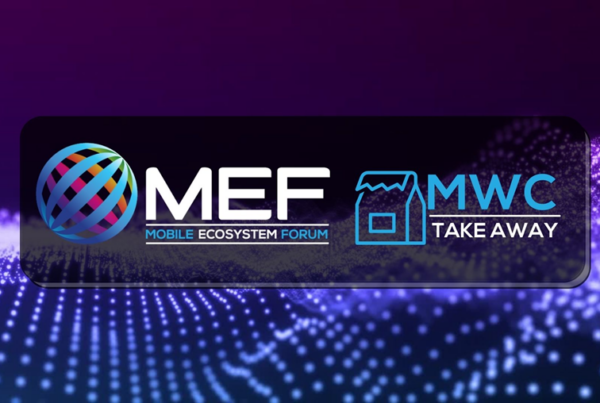Accenture’s 2017 Banking Technology Vision report explores the role of AI in banking and customer engagement. It found that 78 per cent of bankers believe AI will revolutionise the way banks gather information and interact with customers.
One of the key advantages highlighted was that whilst AI is increasingly automating customer interaction, it is also providing a more personalised experience.
Chatbots for example are being used by banks to handle routine enquiries and represent a more personalised experience than visiting the modern day substitute for branch banking, a website or app, where customers interact with layers of screens and drop-down menus instead of a person.

We asked MEF members and the wider business and technology community what they thought would be the impact of AI going forward. Here’s what they said…
Cliff Holsenbeck, Director Product Management, iconectiv
Artificial Intelligence (AI) may soon bring innovation to banking fraud protection which could become even more powerful when it is aligned with other forms of authentication such as SMS messaging.
The question is how should they work together to drive customer protection? Pew Research estimates that 81% of cell phone owners regularly use text messages. That exceedingly high open-and-read rate of SMS could compliment AI advancements. AI is expected to better predict and help stop fraudulent activity in the banking sector working in concert with SMS, the two could further help notify consumers of suspicious banking activity.
When properly managed, SMS messaging provides banks with a fast and secure digital engagement method that is trusted and recognized by consumers as a safe and legitimate communication from a valid entity. Common short codes, five or six digit mobile codes, provide an affordable and trusted option to facilitate this communication, allowing customers to opt into receiving alerts on their smartphone immediately following a transaction, while helping build brand awareness for banks through highly effective communication.
Adrian Benic, VP of Products at Infobip
The majority of banks will introduce elements of artificial intelligence into customer engagement solutions, but it’ll happen gradually and for specific use cases. That’s because it’s more about augmenting the existing customer engagement processes with AI, than overthrowing current paradigms and replacing everything with an AI engine overnight.
Chatbots will certainly be used to automate aspects of customer engagement in the near future. But that’s not to say 2017 will be the year this technology goes mainstream, and the main reason is that the AI technologies behind chatbots are still largely in development.
The underlying technologies are based on probabilities, so the adoption of chatbots will depend on what brands identify as being good enough for them, i.e. the amount of mistakes they’re willing to allow for chatbot interactions with their customers. For banks, the cost of a mistake is still greater than potential gains on the automation side. In retail, adoption will likely be faster.
Matt Hooper, SVP of Global Marketing at IMImobile
Traditional finance companies believe that 40% of their revenue is at risk due to emerging tech-savvy start-ups using the latest automation technology to strike a note with today’s consumers, according to recent research.
At the forefront of this competitive pressure is AI-powered chatbots, which are disrupting the way consumers access information, gain advice and have financial services delivered to them. With Gartner expecting 85% of customer interactions to be automated by 2020, traditional finance companies must look to deploy AI-based customer interactions to compete – and choosing the right CAP (Conversational AI Platform) and approach is crucial.
When formulating their go-to-market chatbot strategy, financial services providers should consider the following points:
Internal preparation
- Ensure key teams understand how machine learning can be used to improve business outcomes.
- Identify and prioritise key use cases for initial experiments.
- Consider a specialist bot writer to get the tone and persona right for your audience.
The chatbots
- The chosen solution should have the sophistication to understand natural language and context for maximum “human” interaction.
- Understand that the more complex your decision tree structure, the more sophisticated your chatbots must be (i.e. able to deal with unfamiliar questions).
The platform
- Consider a low-code solution which will easily integrate into your existing business processes, software and platforms.
- Look for the ability to configure and make changes speedily.
Ensure the provider has the proper accreditation and clearance for accessing and handling personal customer data.
Tim Fujita-Yuhas, Director Product Management and New Product Strategy, OpenMarket
In addition to the obvious perks like convenience, immediacy, and ease of use, one of the powerful applications of AI in the mobile sphere is textmessaging’s adoption of chatbot technology. Thanks to chatbots’machine learning capabilities, based on “remembering” past exchanges and making logical, accurate assumptions about context and customer intent, the opportunities for businesses to capitalize on the technology are endless and cost-efficient.
AI has been steadily building momentum, and it’s only going to continue gaining strength for better customer engagement. Combine this trend with SMS, which is the preferred mobile channel of interaction between millennials and brands, and chatbots are the natural evolution. For example, a hospitality company can use AI service bots and SMS to answer common hotel guest queries, such as WIFI codes, room service requests and check-in/out times. The ROI and improvement in customer experience is at least an order of magnitude better.
Sharad Thukral, CEO Middle East & Africa, Route Mobile
Although most enterprises are still in early stages of innovation or adoption, Artificial Intelligence (AI) technology is progressively available for developers, with vendors offering a range of APIs and frameworks to personalise services.
There are growing numbers of instances, where the technology is being used to enhance back office and consumer-facing systems and processes to ultimately impact workforce efficiency and budgets. We have noticed, AI is also helping enterprises to identify potential business opportunities in ‘data’ – opportunities that would otherwise be missed.
As the Accenture report points out, major adoption of AI is not only the future, it is already visible in banking / insurance companies. At Route Mobile, we’ve seen AI technology being deployed in robots to;
- significantly reduce the response time to customers whilst increasing accuracy, thereby exponentially improving productivity, efficiency and customer experience;
- engage customers in spreading awareness about products and services.
As the popularity of AI technology grows, there are certain elements that are critical for successful deployment, including: expertise, access to historical and accurate customer data, regulatory approvals and sufficient cloud storage for the vast data being generated.
Looking ahead, as a global messaging & voice provider we will be able to play an important role for banks / insurance companies to enable AI systems, helping them reduce the call-load coming in to call-centres by automating their global voice or SMS messages for routine queries from clients, ultimately improving their customer experience exponentially.
Matt Payne, head of creative technology, We are Social
When it concerns their money, customers want an answer instantly. AI and chatbots will deliver this faster than any other method on the market. Banks already have access to the data that they need to offer a personalised, automated service – now it is purely a technical and infrastructural challenge.
Having AI manage customers for actual banking needs may still be a couple of years away, but chatbots are already great for simple applications like FAQs. RBS plans to roll out “robo-advice” for mortgages later this year, allowing customers to get automated mortgage recommendations, while future AIs will answer user questions before the user is even aware of them.
Eventually automated assistants will start using voice as well as text, raising the question: what does your bank sound like? An AI powered voice would be able to tailor itself and its tone to the listener, creating more realistic interactions with customers.
Rurik Bradbury, Global Head of Research at LivePerson
Only 12.4% of Americans would trust a text bot to assist in finding and applying for a credit card — you might call this a “trust issue”. However, when it comes to simpler tasks, like checking balances, moving small sums of money, or making payments, bots can be very helpful. We are seeing innovative earlier projects today, and predict wide adoption in 2018.
The shift to messaging, inside the apps of major banks, will make AI and bot use inevitable, in the same way that ATMs now handle much of the routine tasks that tellers used to.
One large UK bank is currently using bots through the LivePerson platform to help its customer service staff focus on complex issues while allowing bots to handle the more routine questions. This saves a significant amount of tedious work for the bank’s staff, and costs for the bank.
Bhupendra Gupta, EVP – Transformation & Product Engineering at Firstsource Solutions
Automation and chat bots are the latest technology trends that banks are starting to exploit. Despite some well publicised incidents of bots backfiring, they nonetheless have an important role to play in shepherding customers on relatively linear journeys, such as everyday banking queries. We’re already seeing many brands such as eBay and Starbucks use bots both in-app and on social platforms, so it’s only a matter of time before more banks start dipping their toes in the chatbot water to provide their customers with a more integrated and immediate service.
By delivering a personalised, cost effective interface with the consumer, bots can free up agents to support customers with more complex queries – so it’s a win win for businesses who get it right.
Adam Gabrault, VP & Global Head of Mobile, AI & Digital Labs at VirtusaPolaris
AI-driven voice recognition is becoming more popular for the simple reason that it’s far more natural than typing. We’re predisposed to talking to people as the best way to communicate and that idea is just being extended to machines.
As voice recognition software improves, more and more devices will be voice controlled. What will be interesting is the extent to which it moves into the public sphere. Talking with our devices at home is becoming fairly well accepted – with the launch of the Amazon Echo and Google Home – but it remains to be seen if we’ll have cafes and bars where everyone is speaking to their phone to get in touch with their bank, rather than typing. Right now, we’re seeing banks such as Santander pushing voice recognition as it does help to make them more efficient. Furthermore, once customers become aware of the advantages, AI-driven voice recognition could really take off and follow a similar trajectory to contactless payments in winning people over very quickly.
If you would like to contribute a comment to this article contact us at editorial@mefmobile.org or leave your thoughts in the replies below.
Download the Future of Messaging Guide
The Future of Messaging Guide explores the uses cases, platforms & technologies that are changing the landscape of messaging globally. From A2P to OTT, chat bots to smart machines, we explore how the world’s most powerful medium is shaping up for tomorrow.
The guide features over 25 cross-sector case studies and exclusive interviews that examine the power of messaging in all its forms from the humble SMS and chat apps to emerging platforms and explores what’s next for messaging.
Download the free Guide















One Comment